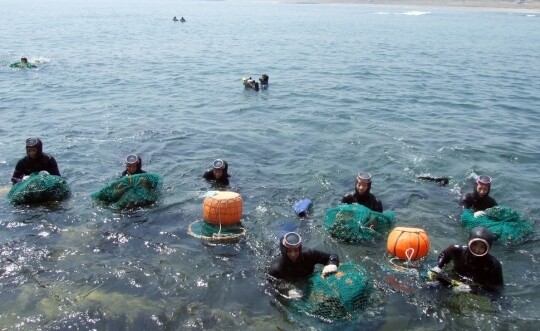hankyoreh
Links to other country sites 다른 나라 사이트 링크
Jeju’s haenyeo divers added to UNESCO’s Intangible Cultural Heritage list

Jeju Island’s unique culture of female divers, called haenyeo, has made its way onto UNESCO’s List of the Intangible Cultural Heritage of Humanity.
The Cultural Heritage Administration (CHA) announced on Dec. 1 that Jeju’s haenyeo culture had been officially added to the List of the Intangible Cultural Heritage of Humanity during a review held that day by the UNESCO Intergovernmental Committee for the Safeguarding of the Intangible Cultural Heritage in the Ethiopian capital of Addis Ababa. It becomes South Korea’s 19th listed example of Intangible Cultural Heritage of Humanity.
According to the CHA, the committee’s decision praised the culture’s symbolism of a region’s distinctive cultural identity, its preservation of an ecologically sustainable environment, and its community-based transmission of knowledge and techniques. In October, an expert review board with the committee recommended the listing of Jeju haenyeo culture, which it said met all five standards for Intangible Heritage review.
The concept of Jeju culture encompasses diving activities to catch seafood in the ocean without special diving apparatus; the “jamsugut” ceremony held by the divers to pray for peace and build a sense of community; the working songs the divers sing on their boats; the roles of women passed down through the generations from mother to daughter and mother-in-law to daughter-in-law; and the identity of the local Jeju Island community.
South Korea’s first contribution to the List of the Intangible Cultural Heritage of Humanity came in 2001 with the Royal Ancestral Ritual in the Jongmyo Shrine and its music. Other forms added to the list since then include the Pansori epic chant (2003); the Gangneung Danoje Festival (2005); Namsadang performing arts, the Ganggangsullae dance, the Yeongsanjae Buddhist ceremony, the Jeju Chilmeoridang Yeongdeunggut ritual, and the Cheoyongmu dance (all in 2009); Gagok lyric song cycles, falconry, and Daemokjang wooden architecture (all in 2010); tightrope-walking, fine ramie weaving, and taekkyeon (all in 2011); the Arirang folk song (2012); annual kimchi-making (2013); Nongak community band music (2014); and tug-of-war (2015).
To commemorate the listing, the CHA plans to display around 150 related items along with photographs and videos at a special haenyeo culture exhibition at the National Intangible Heritage Center in Jeonju from Dec. 5 to Mar. 31 of next year. Jeju Province also plans to hold a world heritage registration proclamation ceremony sometime this month.
By Roh Hyung-suk, staff reporter
Please direct questions or comments to [english@hani.co.kr]

Editorial・opinion
![[Column] Season 2 of special prosecutor probe may be coming to Korea soon [Column] Season 2 of special prosecutor probe may be coming to Korea soon](https://flexible.img.hani.co.kr/flexible/normal/500/300/imgdb/original/2024/0426/3317141030699447.jpg) [Column] Season 2 of special prosecutor probe may be coming to Korea soon
[Column] Season 2 of special prosecutor probe may be coming to Korea soon![[Column] Park Geun-hye déjà vu in Yoon Suk-yeol [Column] Park Geun-hye déjà vu in Yoon Suk-yeol](https://flexible.img.hani.co.kr/flexible/normal/500/300/imgdb/original/2024/0424/651713945113788.jpg) [Column] Park Geun-hye déjà vu in Yoon Suk-yeol
[Column] Park Geun-hye déjà vu in Yoon Suk-yeol- [Editorial] New weight of N. Korea’s nuclear threats makes dialogue all the more urgent
- [Guest essay] The real reason Korea’s new right wants to dub Rhee a founding father
- [Column] ‘Choson’: Is it time we start referring to N. Korea in its own terms?
- [Editorial] Japan’s rewriting of history with Korea has gone too far
- [Column] The president’s questionable capacity for dialogue
- [Column] Are chaebol firms just pizza pies for families to divvy up as they please?
- [Column] Has Korea, too, crossed the Rubicon on China?
- [Correspondent’s column] In Japan’s alliance with US, echoes of its past alliances with UK
Most viewed articles
- 1‘We must say no’: Seoul defense chief on Korean, USFK involvement in hypothetical Taiwan crisis
- 2N. Korean delegation’s trip to Iran shows how Pyongyang is leveraging ties with Moscow
- 3‘Weddingflation’ breaks the bank for Korean couples-to-be
- 4Korea sees more deaths than births for 52nd consecutive month in February
- 5[Editorial] New weight of N. Korea’s nuclear threats makes dialogue all the more urgent
- 6[Column] Has Korea, too, crossed the Rubicon on China?
- 7[Column] Park Geun-hye déjà vu in Yoon Suk-yeol
- 8[Guest essay] The real reason Korea’s new right wants to dub Rhee a founding father
- 9Amnesty notes ‘erosion’ of freedom of expression in Korea in annual human rights report
- 10[Reportage] On US campuses, student risk arrest as they call for divestment from Israel